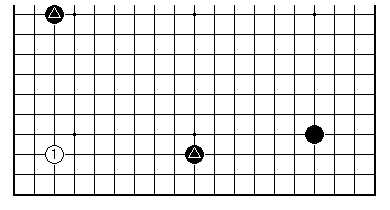

In this article I'll introduce the 3-3 point. And then with 4-4, 3-4, 3-3 and 5-3 points covered, the vast majority of corner opening plays seen in modern Go will be accounted for.
I was talking last time about a taboo from classical Go, and the considered choice of plays in an empty corner. In the eyes of the classical masters there was a ban on playing the 3-3 point corner opening at all. To begin with, I want to explain why that prohibition was too sweeping, according to current notions, in particular for empty corner occupation.

The nature of the 3-3 point can be understood through this schematic example. Supposing White needs to play in the lower left corner, when the two marked black stones are already in place. Then White 1 is ideal.
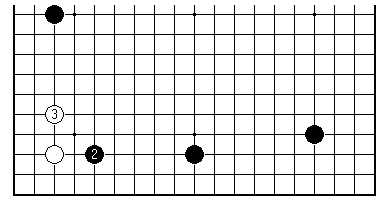
The reason is that White's life in the corner will not be threatened. After Black 2, White 3 is simple and good. You can say that the points 2 and 3 are miai. In any case White is quite comfortable here.
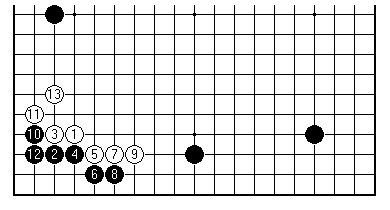
In contrast, White 1 at the 4-4 point isn't a good idea. If Black immediately invades at the 4-4 point, the standard sequence leaves White short of a plan for further development. In fact Black's stones on the sides occupy two points that can be considered miai; since Black has both, it is hard for White to get a good result.
These examples are artificial, though they convey a correct way of thinking. Here's an early use of the 3-3 point in a related context.
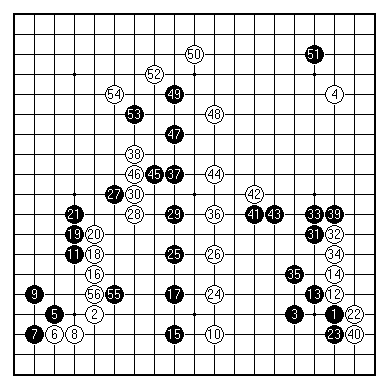
This is from a game played in 1891 between Osawa Ginjiro 4 dan, one of the few 'southpaw' Go players (being left-handed he started in the top left, from his point of view, the bottom right as we look at it), and Tamura Hoju 2 dan (White), the future Honinbo Shusai. White 10 on the lower side exceeds the conventional length of extension at 15 by such a margin that Black invades almost immediately. In the subsequent running fight neither player finds time to occupy the top left corner.
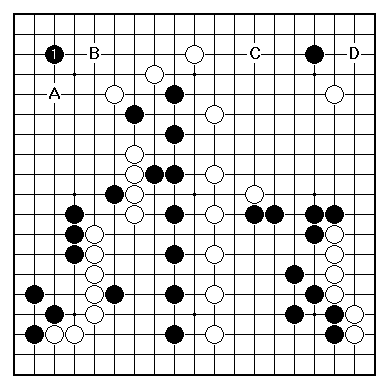
Black's next play was at 1 in the upper left corner. In this position the virtues of the miai points A and B for Black are fairly clear. White B, Black A is unambitious for White, while White A, Black B leaves White with serious weaknesses. If we look instead at the top right corner, the points C and D also are like miai for Black, but White might be able to develop a more effective attack here.
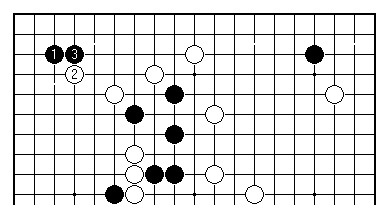
It seems that the traditional dislike of the 3-3 opening was because of the shoulderhit reply at the 4-4 point, as with White 2 here. In this case White 2 is a pointless play and Black 3 a quite adequate answer.
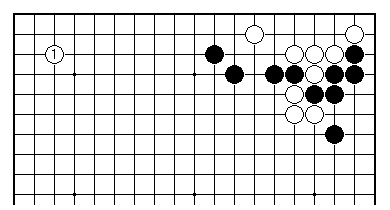
Reaching back into Japan of the nineteenth century, here is a position that might have arisen in the celebrated sequence of victories of Shusaku of the Honinbo house, in the 'Castle' or official games commissioned by the shoguns. In this game Shusaku-Yasui from 1851 the first 19 plays were all in the top right corner, following an opening pattern that is still current today.
Playing next at the 3-3 point upper left is a suggestion by Sanno (commentary in Invincible: The Games of Shusaku).
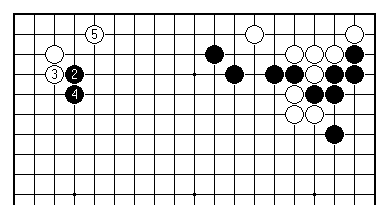
In this case too the shoulderhit Black 2 is out of focus. White 5 is well placed to stop Black using the stones on the top side in combination.
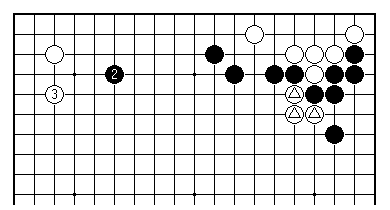
The more modern approach of Black 2 allows White quick life with 3. Very soon the fate of the three marked white stones will be in question; the value to White of dealing rapidly with the corner shouldn't be underestimated.
In the real game Yasui played a different way (at the 4-5 point), and consequently didn't retain control of the corner. Well, modern Go has been the subject of intensive research, though hardly exhaustive. In the case of the 3-3 point new chapters of technique have been opened up, starting rather tentatively in the 1930s, and fashionably in the Sakata ascendancy of the early 1960s.

It is not however true to say that the 3-3 point was unknown in classical Go. Here is another of Shusaku's games, from 1844; in it as White he occupies the lower right corner at 3-3. The thinking seems in a way quite modern, with White 4 at 4-4 too. Both 4-4 and 3-3 plays favour rapid development, the second plays in the corners being less urgent. (Black was Sanai Tokujiro, also of the Honinbo house, and a travelling companion of Shusaku; this may well have been an exhibition game.)
In a diagonal pattern (Black 1 and 3 in opposite corners) each side is typically divided between the players. Four shared sides, rather than two if Black 1 and 3 are along one side of the board, can make for sudden complexity. The 3-3 point is often used in contemporary Go by White to stake out one corner quickly. The assumption is that fighting elsewhere will be quite enough to occupy White's attention.
[01]
[02]
[03]
[04]
[05]
[06]
[07]
[08]
[09]
[10]
[11]
[12]
[13]
[14]
[15]
[16]
[17]
[18]
[19]
[20]
[21]
[22]
[23]
[24]
[25]
[26]
First published 29 March 2001 as On Your Side on MindZine,
Go Learning
© Charles Matthews 2000.